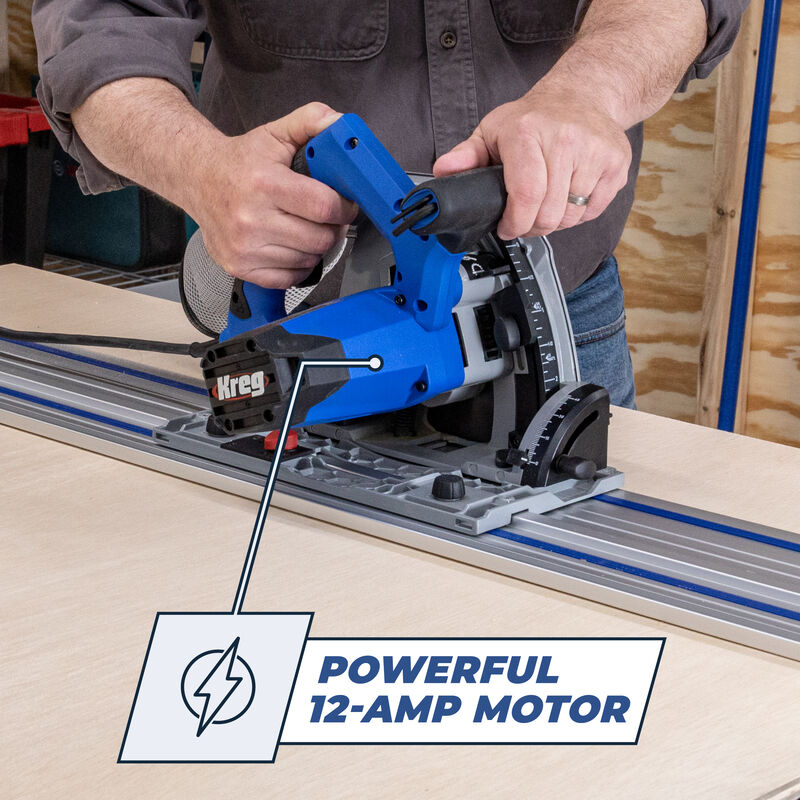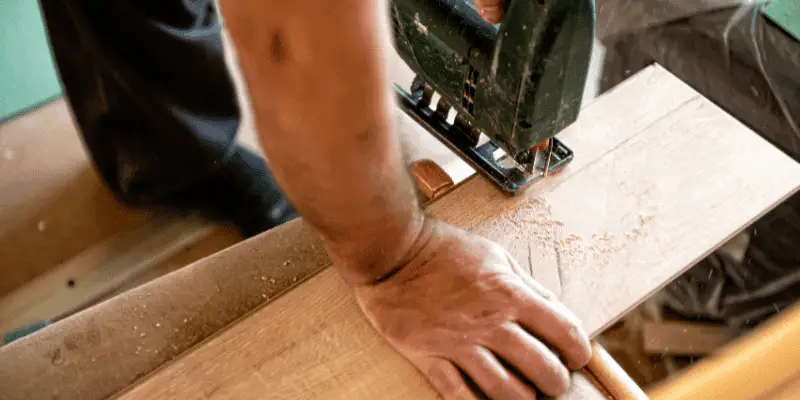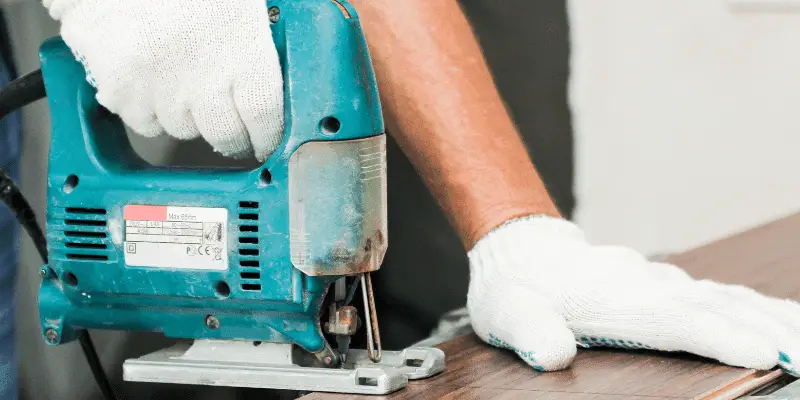To cut a laminate countertop with a jigsaw, mark the cutting line, apply masking tape to prevent splintering, and make slow, steady cuts using a fine-toothed blade. When it comes to cutting a laminate countertop, it’s important to follow the right steps to ensure a smooth and precise cut.
Whether you are installing a new countertop or making modifications to an existing one, using a jigsaw can be a practical tool for the job. In this guide, we will walk you through the process of cutting laminate countertops with a jigsaw, providing you with helpful tips and techniques to achieve accurate cuts.
By following these steps, you can easily tackle this DIY project and achieve professional-looking results.
Choosing The Right Jigsaw Blade For Cutting Laminate Countertop
Choosing the right jigsaw blade is crucial for cutting laminate countertops effectively. With the proper blade, you can achieve clean and precise cuts, ensuring a professional-looking result for your project. Let’s explore how to cut laminate countertops with a jigsaw and the factors to consider when selecting the right blade.
When it comes to cutting laminate countertops with a jigsaw, choosing the right blade is crucial for achieving clean and precise cuts. The wrong blade can result in chipping, splintering, or rough edges, which can ruin the look of your countertop.
To make sure you get the best results, there are a few factors you should consider when selecting a jigsaw blade. Here are some important points to keep in mind:
Factors To Consider When Selecting A Jigsaw Blade:
- Blade Material: Jigsaw blades for cutting laminate countertops are typically made from either high-speed steel (HSS) or carbide-tipped materials. HSS blades are suitable for occasional use and are more affordable, while carbide-tipped blades are more durable and designed for heavy-duty cutting.
- TPI (Teeth per Inch): The TPI refers to the number of teeth on the blade. A higher TPI means a smoother cut, but it also results in slower cutting speed. For laminate countertops, a blade with a TPI ranging from 8 to 12 is recommended to strike a balance between speed and smoothness.
- Blade Design: The design of the blade teeth is another essential factor to consider. For cutting laminate countertops, a blade with a downward or reverse-cutting tooth design is preferred. This design helps minimize chipping and splintering on the decorative surface of the laminate.
- Blade Length: The length of the blade should be determined by the thickness of your laminate countertop. A blade that protrudes around 1/4 inch beyond the material is generally suitable for most laminate countertop cutting tasks.
Different Types Of Jigsaw Blades Suitable For Cutting Laminate Countertop:
- High-Speed Steel (HSS) Blades: HSS blades are an affordable option for cutting laminate countertops. While they may not offer the same durability as carbide-tipped blades, they are still capable of producing decent results for occasional use.
- Carbide-Tipped Blades: These blades are ideal for heavy-duty cutting tasks. The carbide tips provide superior cutting performance and longevity. They are more expensive than HSS blades but are worth the investment if you have a lot of cutting to do.
- Downward-Cutting Blades: These blades have teeth that cut on the downstroke, which helps minimize chipping and splintering on the laminate surface. They are specifically designed for cutting laminate, making them an excellent choice for achieving clean and precise cuts.
- Reverse-Tooth Blades: Similar to downward-cutting blades, reverse-tooth blades also help minimize chipping and splintering. They have teeth that face in the opposite direction, allowing for a smooth cut on the laminate surface.
Remember to choose the right blade for your specific cutting needs to ensure a successful laminate countertop cutting project. With the right blade, you can achieve clean and precise cuts that will enhance the beauty of your countertop.

Credit: www.kregtool.com
Preparing The Laminate Countertop For Cutting
Preparing a laminate countertop for cutting with a jigsaw is essential to ensure a clean and accurate result. By following the proper steps, such as measuring and marking the countertop, protecting the surface, and using the right blade, you can achieve a smooth and precise cut for your project.
Measuring And Marking The Cutting Line
- Before you begin cutting your laminate countertop with a jigsaw, it’s crucial to accurately measure and mark the cutting line. This step ensures precise cuts and avoids any unwanted mistakes. Here’s how you can do it:
Securing The Countertop To Prevent Slipping During Cutting
- To ensure a smooth and controlled cutting process, it is essential to secure the laminate countertop properly. This helps prevent any slippage or movement during the cutting operation. Follow these steps to secure the countertop:
- Place the laminate countertop on a stable work surface, such as sawhorses or sturdy tables.
- If necessary, use clamps to hold the countertop in place and prevent any shifting during cutting.
- Make sure the countertop is well-supported and does not wobble or move while you work.
Remember, taking the time to secure the countertop adequately will help ensure clean and accurate cuts, giving you the desired results.
Now that you know how to prepare your laminate countertop for cutting, you’re ready to move on to the next step: actually cutting the countertop with a jigsaw. Stay tuned for the upcoming section where we’ll guide you through the process in detail.
Step-By-Step Guide On Cutting Laminate Countertop With A Jigsaw
Learn how to cut laminate countertops with a jigsaw using our step-by-step guide. This easy-to-follow tutorial will help you achieve clean and precise cuts for your countertop installation project.
Setting Up The Jigsaw For Precise Cuts:
- Choose a jigsaw with variable speed settings and orbital action feature.
- Ensure the blade is securely tightened and compatible with cutting laminate.
- Attach a fine-toothed blade with minimum 10-12 teeth per inch for smoother cuts.
- Adjust the orbit setting to low for more controlled cuts.
- Secure the laminate countertop firmly in place to prevent slipping.
Installing The Appropriate Blade:
- Select a jigsaw blade specifically designed for cutting laminate countertops.
- Ensure the blade is long enough to cut through the entire thickness of the countertop.
- Attach the blade correctly, following the manufacturer’s instructions.
- Double-check that the blade is securely fastened before proceeding.
Adjusting The Speed And Orbital Settings:
- Set the jigsaw speed to a medium level for laminate countertop cutting.
- Adjusting the speed too low may cause burning, while too high may result in a rough cut.
- Choose the appropriate orbital setting based on the countertop thickness and desired accuracy.
- Lower orbital settings reduce the risk of chipping the laminate surface.
Making The Initial Cut:
- Measure and mark the cutting line on the laminate surface using a straightedge or template.
- Begin the cut from an inconspicuous location to minimize potential damage to visible areas.
- Place a piece of masking tape along the marked line to further reduce surface chipping.
- Start the jigsaw and carefully guide the blade into the laminate at the marked starting point.
Positioning The Jigsaw And Aligning With The Marked Line:
- Hold the jigsaw parallel to the marked cutting line for a precise cut.
- Maintain a firm grip on the jigsaw while keeping it steady throughout the cutting process.
- Align the blade with the marked line and aim to follow it as closely as possible.
- Keep an eye on the blade, making sure it remains on track while cutting.
Applying Steady And Even Pressure While Cutting:
- Apply gentle and consistent pressure to the jigsaw, allowing the blade to smoothly cut through the laminate.
- Avoid pushing or forcing the jigsaw too hard, as this may cause the blade to deflect or break.
- Maintain a steady hand and let the jigsaw’s weight do most of the work.
- Use a slow and controlled motion, especially when cutting through thicker portions of the countertop.
Navigating Corners And Curves:
- For outside corners, angle the jigsaw slightly to make a beveled cut for a cleaner edge.
- Inside corners can be maneuvered by making relief cuts to ease turning the jigsaw.
- Take extra caution when approaching tight curves to prevent the blade from veering off course.
- Use both hands to guide the jigsaw smoothly while following the curved line.
Techniques For Cutting Rounded Corners:
- To cut rounded corners, use a drill with a suitable-sized hole saw to create a starting point.
- Insert the jigsaw blade into the pre-drilled hole and carefully follow the rounded line.
- Maintain a steady speed and adjust the jigsaw angle as required to cut along the curve smoothly.
Making Relief Cuts For Tight Curves:
- For tight curves, make relief cuts by piercing the countertop alongside the marked line.
- Create multiple relief cuts close together, allowing for easier maneuverability around the curve.
- Take care not to cut beyond the marked line, as it may affect the final shape of the countertop.
- Gradually connect the relief cuts by gently guiding the jigsaw to follow the curve.
Finishing The Cut Smoothly:
- Continue cutting along the marked line until the entire countertop section is separated.
- Slow down the jigsaw speed towards the end of the cut to prevent splintering or chipping.
- Keep the jigsaw steady and maintain a consistent speed for a smoother finish.
- Avoid abruptly stopping the jigsaw before completing the cut to prevent damage to the laminate.
Using A File Or Sandpaper To Smoothen Rough Edges:
- After cutting, use a file or sandpaper to smooth out any rough or jagged edges.
- Lightly sand one direction to avoid scratching or damaging the countertop surface.
- Take your time to ensure a uniform and even finish along the cut edges.
- Wipe off any dust or debris before proceeding with further countertop installation.

Tips And Tricks For A Successful And Safe Cut
Learn the tips and tricks for a successful and safe cut of a laminate countertop with a jigsaw. This guide will help you achieve accurate and clean cuts, ensuring a professional finish.
Cutting a laminate countertop with a jigsaw requires precision and caution to avoid any mishaps. By following some best practices and taking safety precautions, you can ensure an accurate and clean cut. Here are some tips and tricks to help you achieve a successful and safe cut:
Best Practices For Accurate And Clean Cuts:
- Measure twice, cut once: Before starting the cutting process, make sure to measure the area where the countertop needs to be trimmed. Double-check the measurements to ensure accuracy and minimize the chances of errors.
- Mark the cutting line: Using a pencil or masking tape, mark the cutting line on the surface of the laminate countertop. This will serve as a guide to follow during the cutting process.
- Use the right blade: Selecting the appropriate blade for your jigsaw is crucial. A fine-toothed blade designed specifically for laminate or plastic materials will ensure clean and precise cuts without chipping or splintering.
- Take your time: Cutting too quickly or rushing through the process can lead to mistakes. Take your time and move the jigsaw at a steady pace, allowing the blade to do the work without excessive force.
- Support the countertop: To prevent the laminate countertop from splintering or vibrating excessively during the cut, support it with sawhorses or a sturdy work surface. This will help maintain stability and minimize vibrations.
Using A Straight Edge Or Guide For Straight Cuts:
- Attach a straight edge: For straight cuts, attach a straight edge or guide along the marked cutting line. This will act as a guide for the jigsaw and ensure a straight and accurate cut.
- Clamping the straight edge: To secure the straight edge in place, use clamps to hold it firmly against the countertop. This will help maintain stability and prevent the straight edge from shifting during the cutting process.
Avoiding Excessive Pressure That Can Damage The Countertop:
- Let the jigsaw do the work: It’s important not to apply excessive pressure on the jigsaw while cutting the laminate countertop. Allow the blade to cut through the material naturally without forcing it, to prevent any damage or inconsistencies in the cut.
- Maintain a steady hand: Keep a firm grip on the jigsaw while cutting, but avoid applying excessive pressure. Instead, guide the tool smoothly and steadily along the cutting line, allowing the blade to make a clean, even cut.
Safety Precautions When Using A Jigsaw:
- Wear protective goggles and gloves: To protect your eyes from flying debris and your hands from potential injury, always wear safety goggles and gloves while operating a jigsaw. This will minimize the risk of accidents and ensure your safety.
- Keep the work area clear of obstacles: Before starting the cutting process, clear the work area of any obstacles or clutter. This will give you ample space to maneuver the jigsaw safely and avoid any accidents or injuries.
By following these tips and tricks, you’ll be well-equipped to cut a laminate countertop with a jigsaw accurately and safely. Remember to prioritize safety, take your time, and proceed with caution to achieve the desired results.
Troubleshooting Common Issues
Having trouble cutting a laminate countertop with a jigsaw? Follow these step-by-step instructions to troubleshoot common issues and achieve a clean cut effortlessly. Say goodbye to uneven edges and enjoy a perfectly customized countertop.
When it comes to cutting a laminate countertop with a jigsaw, there are a few common issues that you might encounter. But fear not! With a little bit of knowledge and some troubleshooting techniques, you can overcome these challenges and achieve a clean and precise cut.
In this section, we will discuss how to prevent chipping or splintering during cutting and how to deal with blade wander or veering off the marked line. Let’s dive in and tackle these problems head-on!
Preventing Chipping Or Splintering During Cutting:
- Use a fine-toothed blade: Opt for a jigsaw blade with more teeth per inch to minimize the chances of chipping or splintering.
- Apply masking tape: Before starting the cut, place masking tape on the surface of the laminate countertop along the cutting line. This can help reduce chipping by providing extra support.
- Adjust the cutting speed: Slow down the jigsaw’s cutting speed when working with a laminate countertop. This allows the blade to make precise and clean cuts, minimizing the risk of chipping.
- Support the countertop: Provide adequate support for the countertop by using sawhorses or a stable workbench. This prevents the material from vibrating excessively, decreasing the likelihood of chipping.
Dealing With Blade Wander Or Veering Off The Marked Line:
- Use a guide: Attach a straightedge or a guide rail to the countertop surface to serve as a reference for the jigsaw’s baseplate. This helps keep the blade aligned with the desired cutting line, reducing the chance of wandering.
- Take it slow: Instead of trying to rush through the cut, take your time and maintain a steady pace. Applying excessive pressure or moving too quickly can cause the blade to deviate from the intended path.
- Start with a pilot hole: To ensure accuracy, begin by drilling a small pilot hole at one end of the cutting line. This helps guide the jigsaw blade and prevents it from wandering off during the initial stages of the cut.
- Double-check your markings: Before making any cuts, double-check the accuracy of your markings. Even a slight deviation in the starting point can lead to blade wander throughout the entire cut.
Remember, practice makes perfect! If you are new to cutting laminate countertops with a jigsaw, it’s essential to start with small, manageable projects before tackling larger ones. With these troubleshooting techniques and a little bit of patience, you’ll soon become a pro at cutting laminate countertops with a jigsaw.

Final Thoughts And Considerations
Looking to cut a laminate countertop with a jigsaw? Consider these final thoughts and considerations before you dive in. Ensure a smooth and accurate cut by following these tips and precautions.
So you’ve decided to take on the challenge of cutting a laminate countertop with a jigsaw. While it can be a cost-effective and efficient option, there are some important considerations to keep in mind. In this section, we will discuss the limitations and risks associated with using a jigsaw for this task, as well as recommendations for both professionals and DIY enthusiasts.
Understanding The Limitations And Risks Of Using A Jigsaw For Cutting Laminate Countertop:
- Limited precision: Jigsaws may not provide the level of precision required for intricate or detailed cuts on laminate countertops. The blade may wander, leading to uneven or jagged edges.
- Potential for chipping: Laminate countertops can be prone to chipping, especially if not properly supported during the cutting process. Jigsaws with aggressive blades can exacerbate this risk.
- Risk of damage to the laminate surface: Excessive vibration and movement of the jigsaw blade can cause damage to the laminate surface, resulting in unsightly scratches or cracks.
- Safety hazards: Using a jigsaw can expose you to potential safety hazards. The blade can be sharp and may cause injury if not handled properly. Additionally, the dust and debris generated during cutting can be harmful if proper safety precautions are not taken.
Recommendations For Professionals And Diy Enthusiasts:
- Invest in the right tools: For professionals, consider using specialized laminate cutting tools like a laminate trimmer or router with a laminate-cutting bit. These tools are designed for precision and minimize the risk of chipping or surface damage. DIY enthusiasts can opt for a jigsaw with a fine-toothed blade specifically designed for cutting laminate materials.
- Take necessary precautions: To reduce the risk of chipping and surface damage, ensure that the countertop is well-supported during the cutting process. Placing masking tape along the cut line can also help minimize chipping. Additionally, wearing appropriate safety gear such as safety goggles and a dust mask is essential.
- Practice on scrap material: Before cutting the actual countertop, it’s always a good idea to practice on scrap laminate material. This allows you to familiarize yourself with the jigsaw’s performance and fine-tune your cutting technique.
- Consider hiring a professional: If precision is crucial or if you’re unsure about your ability to achieve clean cuts, it may be wise to hire a professional to handle the job. They have the expertise and specialized tools necessary to ensure a clean and precise result.
While a jigsaw can be a viable option for cutting a laminate countertop, it’s important to be aware of its limitations and associated risks. By understanding these limitations and following the recommendations provided, you can increase your chances of achieving clean and precise cuts while minimizing the risk of damage.
Frequently Asked Questions For How To Cut Laminate Countertop With Jigsaw
What Kind Of Jigsaw Blade Do You Use To Cut Laminate Countertops?
To cut laminate countertops, use a jigsaw blade specifically designed for laminate materials.
How Do You Cut Laminate Countertops Without Chipping Them?
To cut laminate countertops without chipping them, follow these steps carefully:
1. Use a sharp carbide-tipped blade for your circular saw or jigsaw.
2. Apply masking tape on the cutting line to prevent chipping.
3. Cut slowly and steadily, letting the blade do the work without forcing it.
4. Support the laminate with a stable surface while cutting to minimize vibrations and potential chipping.
What Is The Best Tool To Cut Laminate Countertops?
The best tool for cutting laminate countertops is a circular saw with a fine-tooth blade.
How Do You Cut Laminate Worktops With A Jigsaw?
To cut laminate worktops with a jigsaw, follow these steps:
1. Mark the cutting line on the surface of the laminate worktop.
2. Choose a fine-toothed jigsaw blade suitable for cutting laminate material.
3. Secure the worktop firmly to prevent vibrations during cutting.
4. Start the jigsaw and carefully guide the blade along the marked cutting line to avoid chipping the laminate.
Conclusion
Cutting laminate countertops with a jigsaw might seem intimidating at first, but with the right techniques and tools, it can be a straightforward process. By following these steps, you can achieve clean and precise cuts that will perfectly fit your space.
Start by marking the area you need to cut and attaching a guide rail or fence to ensure straight lines. Choose a fine-toothed jigsaw blade specifically designed for laminate materials, reducing the risk of chipping or splintering. Take your time and let the saw do the work, maintaining a steady pace and applying even pressure.
Remember to wear safety goggles and a dust mask to protect yourself from flying debris. Make sure to practice on scrap pieces before tackling your actual countertop, gaining confidence and skill along the way. With these tips in hand, you can confidently take on a laminate countertop cutting project.
By following proper techniques and precautions, you can achieve professional-looking results without the need for expensive tools or professional assistance. Don’t be afraid to tackle this DIY job—it can save you money and allow you to customize your kitchen or bathroom to your unique tastes and needs.
Get cutting!


